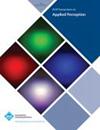色差下的图像质量
IF 1.9
4区 计算机科学
Q3 COMPUTER SCIENCE, SOFTWARE ENGINEERING
引用次数: 5
摘要
本文研究了色差对感知图像质量的影响。在D65标准光源下,将一组高光谱图像表示到CIELAB色彩空间中,并利用k-means算法将相应的色彩坐标细分为簇。每个色簇通过预定义的色差ΔE*ab移动,仅在a*b*色坐标中具有随机方向。将a*b*坐标下的3、6、9、12、15的损伤值分别应用于5张高光谱图像,生成一组修改后的图像。这些图片被展示给受试者,受试者被要求根据它们的自然程度对它们的质量进行排名。计算主观评价的平均意见得分来量化对颜色变化的敏感性。本文还使用几种最先进的度量标准和CIEDE2000色差等对质量进行了客观评估。分析主观和客观质量评价之间的相关性有助于我们得出结论,基于CIEDE2000提出的质量估计器提供了最好的代表性。此外,得出的结论是,建立的质量指标只有通过对每个颜色成分的结果进行平均才能变得可靠。本文章由计算机程序翻译,如有差异,请以英文原文为准。
Image Quality under Chromatic Impairments
The influence of chromatic impairments on the perceived image quality is studied in this article. Under the D65 standard illuminant, a set of hyperspectral images were represented into the CIELAB color space, and the corresponding chromatic coordinates were subdivided into clusters with the k-means algorithm. Each color cluster was shifted by a predefined chromatic impairment ΔE*ab with random direction in a*b* chromatic coordinates only. Applying impairments of 3, 6, 9, 12, and 15 in a*b* coordinates to five hyperspectral images a set of modified images was generated. Those images were shown to subjects that were asked to rank their quality based on their naturalness. The Mean Opinion Score of the subjective evaluations was computed to quantify the sensitivity to the chromatic variations. This article is also complemented with an objective evaluation of the quality using several state-of-the-art metrics and using the CIEDE2000 color difference among others. Analyzing the correlations between subjective and objective quality evaluation helps us to conclude that the proposed quality estimators based on the CIEDE2000 provide the best representation. Moreover, it was concluded that the established quality metrics only become reliable by averaging their results on each color component.
求助全文
通过发布文献求助,成功后即可免费获取论文全文。
去求助
来源期刊

ACM Transactions on Applied Perception
工程技术-计算机:软件工程
CiteScore
3.70
自引率
0.00%
发文量
22
审稿时长
12 months
期刊介绍:
ACM Transactions on Applied Perception (TAP) aims to strengthen the synergy between computer science and psychology/perception by publishing top quality papers that help to unify research in these fields.
The journal publishes inter-disciplinary research of significant and lasting value in any topic area that spans both Computer Science and Perceptual Psychology. All papers must incorporate both perceptual and computer science components.
 求助内容:
求助内容: 应助结果提醒方式:
应助结果提醒方式:


